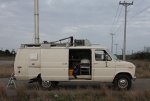|
Really makes sense Johan, thanks. I, know nothing about VPN, and a bit about networking, so I got confused with the different Class C IPs used for the tunneling. Hence, I why I need to read up on GRE protocol and VPN.
At the moment, both routers are still not pinging the other Tunnel IP (192.168.80.1) on one and (192.168.80.2) on the other. I've been running parts of the scripts manually on both mesh routers which deal with assigning and checking IPs within the mesh router and with the IP check at millhill.org server. Both mesh routers are properly configured, as far as I can tell, responding with the proper IPs on the right Interfaces.
The WAN IPs on both mesh routers are updating the DynDNS server correctly after 5 minutes, when I manually put an incorrect IP in DynDNS. So that works fine.
The next thing I will focus on is both Internet router Firewalls. I will be putting both mesh router IPs in the DMZ of the Internet router and see how they react. Hopefully, it's just one or both routers blocking GRE or Port 1723.
Looking at the log files on my Internet router (Internet Sessions) I can see my router sending out a GRE request from my DHCP assigned WAN IP of the mesh router (192.168.1.101) to the outside WAN IP of the remote Internet router (which is listed correctly on DynDNS server). I see nothing in the System Activity log file accept for the mesh DHCP IP assignment. Next item, to check the logs of the remote Internet router to see what's happening there. |
